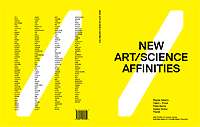New Art/Science Affinities
New Art/Science Affinities (NA/SA) is a book, while focusing on contemporary artists, also alludes to those in .edu Art Departments-nationwide; where all are working globally at the intersection of art, science, and technology co-published by Miller Gallery at Carnegie Mellon University and STUDIO for Creative Inquiry.[1] It focuses on sixty international artists and art collaboratives. The book is accompanied by an exhibition titled Intimate Science, first shown at Miller Gallery at Carnegie Mellon University in January 2012.[2]

Creation
New Art/Science Affinities was designed and written at the Frank-Ratchye STUDIO for Creative Inquiry on Carnegie Mellon University's campus in February 2011. The book was created through a working model for collaborative book authorship known as a book sprint, derived from code sprinting. The project was led by Andrea Grover, recipient of a 2010 Warhol Foundation Curatorial Fellowship, along with three other authors (Régine Debatty, Claire L. Evans and Pablo Garcia) and two designers (Luke Bulman and Jessica Young of Thumb).[3][4][5]
"As a ‘snapshot’ created on the run over seven days, it necessarily portrays a quite particular moment and choice."[6] The publication is not a complete history of the interstices of art, technology, and science, although there is a timeline in the back marking some of the most important events in history including the 1968 exhibition of computer art titled Cybernetic Serendipity at the Institute of Contemporary Arts, London.
Content and featured artists
A common theme that emerges in New Art/Science Affinities is concern for the environment. It’s interesting to note that although four of the book’s six creators are women, male artists outnumber female artists in the book.[7]
Andrea Grover, writes about her discovery while writing the book, "We observed that artists are no longer operating on the periphery of research but conducting research themselves. And when artists become scientists, the lines of inquiry pursued become quite expansive."[8]
The book is divided into 6 chapters with an additional timeline of Art, Science & Technology Intersections. The chapters are:[9]
| Chapter | Authors |
|---|---|
| Program Art or be Programmed | C.E.B. Reas, Rafael Lozano-Hemmer, Jer Thorp, Marius Watz, Aaron Koblin, with comments from Golan Levin |
| Subvert! | Robin Hewlett and Ben Kinsley, Sebastian Brajkovic, Julius von Bismarck, Paul Vanouse, Julian Oliver and Danja Vasiliev, Marco Donnarumma, Willy Sengewald (TheGreenEyl), Boredomresearch, with comments from Julian Oliver, Danja Vasiliev, and Johannes Grenzfurthner |
| Citizen Science | Cesar Harada, HeHe, Critter, Machine Project, Center for PostNatural History, Institute for Figuring, with comments from Cesar Harada and Fred Adams |
| Artists in White Coats and Latex Gloves | Brandon Ballengée, Gilberto Esparza, Philip Ross, BCL, Kathy High, Fernando Orellana, SWAMP, Agnes Meyer-Brandis, SymbioticA and Tissue Culture & Art Project, with comments from Phil Ross and Adam Zaretsky |
| The Maker Moment | Machine Project, Thomas Thwaites, Jonah Brucker-Cohen and Katherine Moriwaki, John Cohrs, Free Art and Technology Lab (F.A.T.), Openframeworks,
The Graffiti Research Lab, and the Ebeling Group with comments from Geraldine Juarez, Mark Allen, and Jonah Brucker-Cohen |
| The Overview Effect | Tomàs Saraceno, Dunne & Raby, Sascha Pohflepp, Bruce Sterling, Atelier van Lieshout, etoy with comments from Jeff Lieberman, Sascha Pohflepp, and Wendy Fok |
References
- Andrea Grover, Régine Debatty, Claire Evans, and Pablo Garcia. New Art/Science Affinities. Published by Miller Gallery at Carnegie Mellon University + CMU STUDIO for Creative Inquiry, 2011. ISBN 978-0-9772053-4-9.
- Press Release, Carnegie Mellon University. Dept. of Media Relations. "Intimate Science" Exhibition Opens at Carnegie Mellon's Miller Gallery, Jan. 20 - March 4. <http://millergallery.cfa.cmu.edu/exhibitions/intimatescience/MillerGalleryOpenIntimateScience_PR010912.pdf> Published 2012-01-09. Retrieved 2012-10-22.
- "New Art/Science Affinities" Miller Gallery at Carnegie Mellon University. <http://millergallery.cfa.cmu.edu/nasabook/> Retrieved 2012-10-22.
- Press Release, Carnegie Mellon University. Dept. of Media Relations. "“New Art/Science Affinities” Book Sprint Published By CMU’s Miller Gallery and STUDIO for Creative Inquiry". <http://millergallery.cfa.cmu.edu/nasabook/NewArtScienceAffinitiesBook_PublishedByCMUMillerGallery&STUDIO_PR.pdf> Published 2011-10-18. Retrieved 2012-10-22.
- Curatorial Fellowships. The Andy Warhol Foundation for the Visual Arts. Published 2012. Retrieved 29-10-2012. <http://www.warholfoundation.org/grant/curatorial_fellowships.html>
- Brian Reffin Smith. Review, Leonardo Online. Published 5-4-2012. Retrieved 29-10-2012. <http://leonardo.info/reviews/apr2012/smith-grover.php>
- Leila Nadir. "Art and Science get Intimate" Hyperallergic: Sensitive to Art & its Discontents. Published 12-4-2012. Retrieved 28-10-2012. <http://hyperallergic.com/49937/art-and-science-get-intimate/>
- Andrea Grover. New Art/Science Affinities. National Endowment for the Arts blog. Published 3-5-2012. Retrieved 29-10-2012. <http://artworks.arts.gov/?p=13060>
- Andrea Grover, Régine Debatty, Claire Evans, and Pablo Garcia. New Art/Science Affinities. Published by Miller Gallery at Carnegie Mellon University + CMU STUDIO for Creative Inquiry, 2011. ISBN 978-0-9772053-4-9.